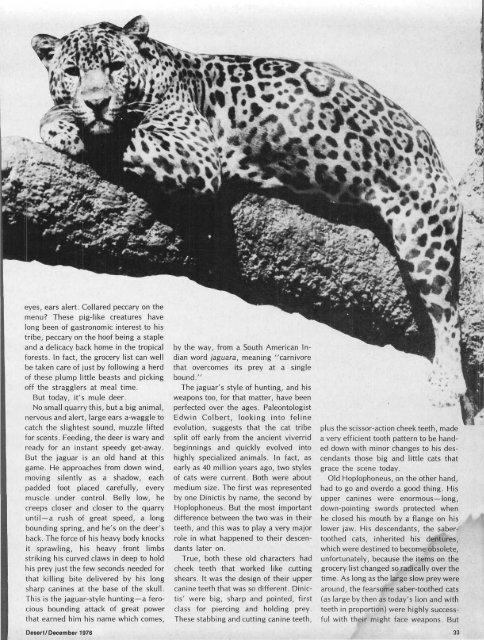1 - Desert Magazine of the Southwest
1 - Desert Magazine of the Southwest
1 - Desert Magazine of the Southwest
You also want an ePaper? Increase the reach of your titles
YUMPU automatically turns print PDFs into web optimized ePapers that Google loves.
e:yes, ears alert. Collared peccary on <strong>the</strong><br />
menu? These pig-like creatures have<br />
long been <strong>of</strong> gastronomic interest to his<br />
tribe, peccary on <strong>the</strong> ho<strong>of</strong> being a staple<br />
and a delicacy back home in <strong>the</strong> tropical<br />
forests. In fact, <strong>the</strong> grocery list can well<br />
be taken care <strong>of</strong> just by following a herd<br />
<strong>of</strong> <strong>the</strong>se plump little beasts and picking<br />
<strong>of</strong>f <strong>the</strong> stragglers at meal time.<br />
But today, it's mule deer.<br />
No small quarry this, but a big animal,<br />
nervous and alert, large ears a-waggle to<br />
catch <strong>the</strong> slightest sound, muzzle lifted<br />
for scents. Feeding, <strong>the</strong> deer is wary and<br />
ready for an instant speedy get-away.<br />
But <strong>the</strong> jaguar is an old hand at this<br />
game. He approaches from down wind,<br />
moving silently as a shadow, each<br />
padded foot placed carefully, every<br />
muscle under control. Belly low, he<br />
creeps closer and closer to <strong>the</strong> quarry<br />
until —a rush <strong>of</strong> great speed, a long<br />
bounding spring, and he's on <strong>the</strong> deer's<br />
back. The force <strong>of</strong> his heavy body knocks<br />
it sprawling, his heavy front limbs<br />
striking his curved claws in deep to hold<br />
his prey just <strong>the</strong> few seconds needed for<br />
that killing bite delivered by his long<br />
sharp canines at <strong>the</strong> base <strong>of</strong> <strong>the</strong> skull.<br />
This is <strong>the</strong> jaguar-style hunting —a ferocious<br />
bounding attack <strong>of</strong> great power<br />
that earned him his name which comes,<br />
<strong>Desert</strong>/December 1976<br />
by <strong>the</strong> way, from a South American Indian<br />
word jaguara, meaning "carnivore<br />
that overcomes its prey at a single<br />
bound."<br />
The jaguar's style <strong>of</strong> hunting, and his<br />
weapons too, for that matter, have been<br />
perfected over <strong>the</strong> ages. Paleontologist<br />
Edwin Colbert, looking into feline<br />
evolution, suggests that <strong>the</strong> cat tribe<br />
split <strong>of</strong>f early from <strong>the</strong> ancient viverrid<br />
beginnings and quickly evolved into<br />
highly specialized animals. In fact, as<br />
early as 40 million years ago, two styles<br />
<strong>of</strong> cats were current. Both were about<br />
medium size. The first was represented<br />
by one Dinictis by name, <strong>the</strong> second by<br />
Hoplophoneus. But <strong>the</strong> most important<br />
difference between <strong>the</strong> two was in <strong>the</strong>ir<br />
teeth, and this was to play a very major<br />
role in what happened to <strong>the</strong>ir descendants<br />
later on.<br />
True, both <strong>the</strong>se old characters had<br />
cheek teeth that worked like cutting<br />
shears. It was <strong>the</strong> design <strong>of</strong> <strong>the</strong>ir upper<br />
canine teeth that was so different. Dinictis'<br />
were big, sharp and pointed, first<br />
class for piercing and holding prey.<br />
These stabbing and cutting canine teeth,<br />
plus <strong>the</strong> scissor-action cheek teeth, made<br />
a very efficient tooth pattern to be handed<br />
down with minor changes to his descendants<br />
those big and little cats that<br />
grace <strong>the</strong> scene today.<br />
Old Hoplophoneus, on <strong>the</strong> o<strong>the</strong>r hand,<br />
had to go and overdo a good thing. His<br />
upper canines were enormous —long,<br />
down-pointing swords protected when<br />
he closed his mouth by a flange on his<br />
lower jaw. His descendants, <strong>the</strong> sabertoo<strong>the</strong>d<br />
cats, inherited his dentures,<br />
which were destined to become obsolete,<br />
unfortunately, because <strong>the</strong> items on <strong>the</strong><br />
grocery list changed so radically over <strong>the</strong><br />
time. As long as <strong>the</strong> large slow prey were<br />
around, <strong>the</strong> fearsome saber-too<strong>the</strong>d cats<br />
(as large by <strong>the</strong>n as today's lion and with<br />
teeth in proportion) were highly successful<br />
with <strong>the</strong>ir might face weapons. But<br />
33

















